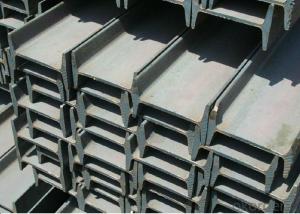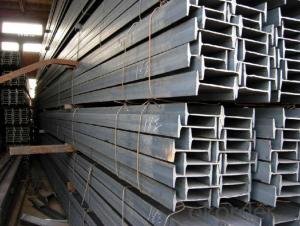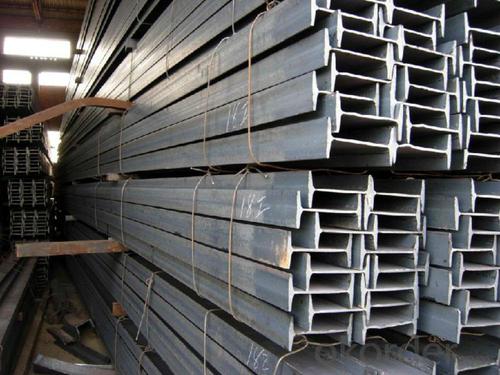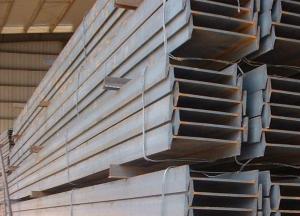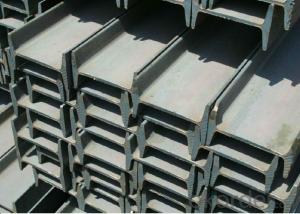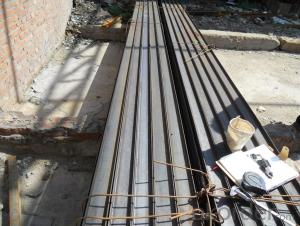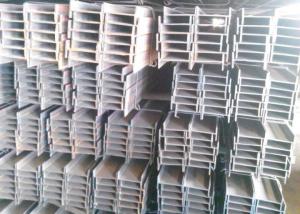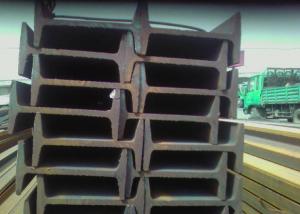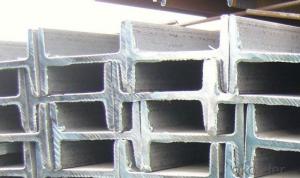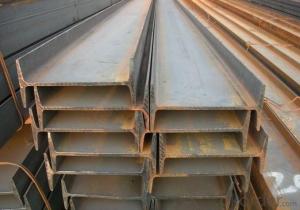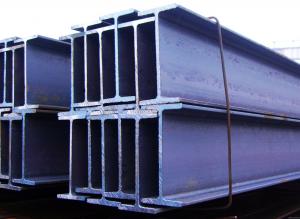Hot Rolled Steel I-Beam with Lowest Price
- Loading Port:
- Tianjin
- Payment Terms:
- TT OR LC
- Min Order Qty:
- 25 m.t
- Supply Capability:
- 10000 m.t/month
OKorder Service Pledge
OKorder Financial Service
You Might Also Like
Specification
OKorder is offering high quality Hot Rolled Steel I-Beams at great prices with worldwide shipping. Our supplier is a world-class manufacturer of steel, with our products utilized the world over. OKorder annually supplies products to European, North American and Asian markets. We provide quotations within 24 hours of receiving an inquiry and guarantee competitive prices.
Product Applications:
IPE/IPEAA Beam Steel are widely used in various construction structures, bridges, autos, brackets, mechanisms and so on.
Product Advantages:
OKorder's Steel I-Beams are durable, strong, and resist corrosion.
Main Product Features:
· Premium quality
· Prompt delivery & seaworthy packing (30 days after receiving deposit)
· Corrosion resistance
· Can be recycled and reused
· Mill test certification
· Professional Service
· Competitive pricing
Product Specifications:
1. Product name: IPE/IPEAA Beam Steel
2. Standard: EN10025, GB Standard, ASTM, JIS etc.
3. Grade: Q235B, A36, S235JR, Q345, SS400 or other equivalent.
4. Length: 5.8M, 6M, 9M, 10M, 12M or as your requirements
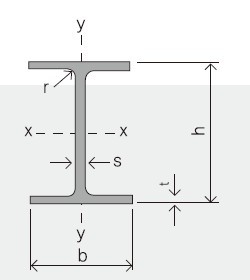
Section | Standard Sectional Dimensions(mm) | ||||
h | b | s | t | Mass Kg/m | |
IPE80 | 80 | 46 | 3.80 | 5.20 | 6.00 |
IPE100 | 100 | 55 | 4.10 | 5.70 | 8.10 |
IPE120 | 120 | 64 | 4.80 | 6.30 | 10.40 |
IPE140 | 140 | 73 | 4.70 | 6.90 | 12.90 |
IPE160 | 160 | 82 | 5.00 | 7.40 | 15.80 |
IPE180 | 180 | 91 | 5.30 | 8.00 | 18.80 |
IPE200 | 200 | 100 | 5.60 | 8.50 | 22.40 |
IPE220 | 220 | 110 | 5.90 | 9.20 | 26.20 |
IPE240 | 240 | 120 | 6.20 | 9.80 | 30.70 |
IPE270 | 270 | 135 | 6.60 | 10.20 | 36.10 |
IPEAA80 | 80 | 46 | 3.20 | 4.20 | 4.95 |
IPEAA100 | 100 | 55 | 3.60 | 4.50 | 6.72 |
IPEAA120 | 120 | 64 | 3.80 | 4.80 | 8.36 |
IPEAA140 | 140 | 73 | 3.80 | 5.20 | 10.05 |
IPEAA160 | 160 | 82 | 4.00 | 5.60 | 12.31 |
IPEAA180 | 180 | 91 | 4.30 | 6.50 | 15.40 |
IPEAA200 | 200 | 100 | 4.50 | 6.70 | 17.95 |
5.Color marking: There will be color marking on both end of the bundle for the cargo delivered by bulk vessel. That makes it easily to distinguish at the destination port.
Tag mark: there will be tag mark tied up on the bundles. The information usually including supplier logo and name, product name, made in China, shipping marks and other information request by the customer.
If loading by container the marking is not needed, but we will prepare it as customer request.
6. Shipment: In containers or in bulk cargo
FAQ:
Q1: Why buy Materials & Equipment from OKorder.com?
A1: All products are carefully selected from China's most reliable manufacturing enterprises. Through its ISO certifications, OKorder.com adheres to the highest standards and a commitment to supply chain safety and customer satisfaction. We can guarantee the quality!
Q2: The products are invoicing on theoretical weight or on actual weight?
A2: We can do it in both manners, it’s according to buyer's requirement.
Q3: Can fit in the containers of 20fts for 6M long ?
A3: Yes, we can put them into the containers in the form sideling, in this way we can save the buyer much ocean freight.
Images:
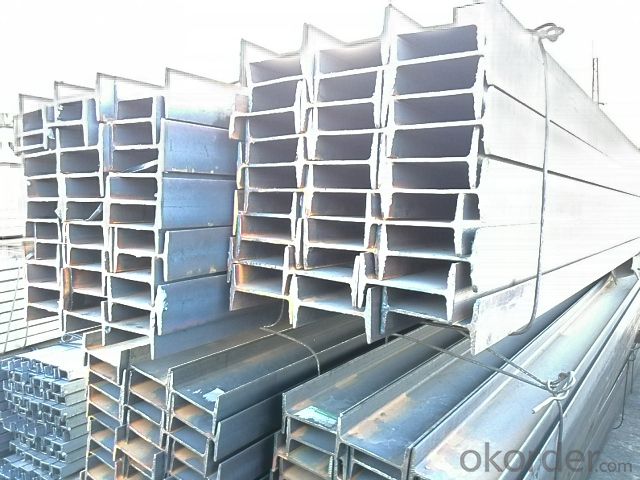

- Q: How are Steel I-Beams connected together?
- Steel I-beams are typically connected together using methods such as welding, bolting, or using specialized connectors like splice plates or shear connectors. These connections ensure structural integrity and stability in various construction applications.
- Q: How do steel I-beams perform in high-snow load areas?
- Due to their inherent strength and load-bearing capabilities, steel I-beams are well-suited for high-snow load areas. The design of the I-beam allows for excellent structural support and even weight distribution across the entire span. This means that steel I-beams can effectively handle the additional weight and stress caused by heavy snow loads. Steel possesses a high strength-to-weight ratio, making it an ideal material for withstanding snow loads. Unlike wood or other building materials, steel is much stronger, enabling I-beams to maintain their structural integrity even under the pressure of heavy snow accumulation. This strength also prevents bending or buckling, ensuring the stability and safety of the structure. Additionally, steel is a durable material that is highly resistant to corrosion and decay. This is particularly important in high-snow load areas where melting snow can create moisture, potentially leading to the deterioration of structural components. Steel I-beams are not susceptible to rot or decay, guaranteeing their long-term performance and reliability in such environments. Moreover, steel I-beams can be customized and engineered to meet specific snow load requirements. By considering factors like anticipated snowfall, snow density, and building design, engineers can calculate the appropriate size and spacing of I-beams to safely support the snow load. This customization ensures that the structure is adequately designed to handle the specific snow load conditions of a given area. In conclusion, steel I-beams are highly effective for high-snow load areas. Their strength, durability, and weight distribution capabilities make them a reliable choice for supporting heavy snow loads. By properly designing and engineering the structure, steel I-beams can provide the necessary stability and safety required in areas prone to significant snow accumulation.
- Q: Can Steel I-Beams be used for elevator shafts?
- Yes, Steel I-Beams can be used for elevator shafts. Steel I-Beams are commonly used in construction for their strength and load-bearing capabilities. Elevator shafts require strong and sturdy materials to support the weight of the elevator car, counterweights, and the passengers. Steel I-Beams provide the necessary structural integrity and support for elevator shafts, ensuring the safety and stability of the elevator system. Additionally, steel is a durable material that can withstand the constant movement and vibrations associated with elevator operation. Therefore, Steel I-Beams are a suitable choice for constructing elevator shafts.
- Q: What are the considerations for steel I-beam design in earthquake-prone areas?
- Several key considerations must be taken into account when designing steel I-beams for earthquake-prone areas to ensure the structural integrity and safety of the building during seismic events. 1. Adherence to Seismic Design Codes: The first priority is to comply with the specific seismic design codes and regulations for the region. These codes provide guidelines and requirements for the design, construction, and performance of structures in earthquake-prone areas. It is crucial to follow these codes to ensure the building's resistance to seismic forces. 2. Careful Material Selection: The type and quality of steel used in the I-beams significantly impact their performance during an earthquake. It is typically preferred to use high-strength steel with good ductility as it can absorb and dissipate energy during seismic shaking. Additionally, the steel should have good corrosion resistance for long-term durability. 3. Precise Beam Sizing and Configuration: The size and configuration of the I-beams must be carefully determined to withstand the anticipated seismic forces. Generally, larger-sized beams with deeper sections are more effective at resisting lateral loads. The spacing and connections of the beams should also be designed to ensure proper load distribution and stability. 4. Incorporation of Ductility and Redundancy: Designing I-beams with adequate ductility is crucial in earthquake-prone areas. Ductile materials can deform without failure, absorbing energy and indicating potential structural damage. Adding redundancy to the beam system, such as multiple interconnected beams, can enhance overall structural integrity and reduce the risk of collapse. 5. Thorough Seismic Load Analysis: A comprehensive seismic load analysis should be conducted to determine the expected forces and accelerations that the I-beams will experience during an earthquake. This analysis considers factors like the building's location, soil conditions, and potential seismic activity intensity. It aids engineers in sizing the beams and designing the necessary connections and supports to resist these forces. 6. Meticulous Connection Design: The connections between the I-beams and other structural elements, like columns and foundations, must be carefully designed to ensure proper load transfer and flexibility. Special attention should be given to the connection's ability to accommodate beam movement during seismic events without compromising the overall stability of the structure. 7. Emphasis on Quality Control and Inspection: Regular quality control and inspection throughout the fabrication, installation, and construction phases are crucial to ensure correct manufacturing and installation of the I-beams. This includes verifying the steel's strength, checking for proper welding, and inspecting the connections for any defects or deficiencies that could compromise the beams' performance during an earthquake. By considering these factors during the design of steel I-beams for earthquake-prone areas, engineers can create structures that are better equipped to withstand seismic forces and ensure the safety of occupants during earthquakes.
- Q: How much weight can I hold for No. 30 I-beam?
- The No. 30 I-beam is a four span continuous beam, span 3 meters, only bending capacity, 10 tons of midspan load is more than enough.So, I think it's not very meaningful for the project to only calculate the beam carefully! Design the whole structure carefully.
- Q: What are the different methods of protecting steel I-beams from fire?
- There are several methods for protecting steel I-beams from fire. One common method is the application of fire-resistant coatings or intumescent paints, which expand when exposed to heat, forming an insulating layer that slows down heat transfer to the steel. Another method is the use of fire-resistant insulation materials, such as mineral wool or ceramic fiber, which are wrapped around the beams to provide thermal protection. Additionally, fireproofing sprays or boards can be applied to the beams to prevent them from reaching critical temperatures during a fire. Finally, encasing the I-beams in fire-rated materials, such as concrete or gypsum board, is another effective way to protect them from fire damage.
- Q: Can steel I-beams be used in schools or educational facilities?
- Yes, steel I-beams can be used in schools or educational facilities. Steel I-beams are commonly used in the construction industry due to their strength, durability, and versatility. They provide structural support to buildings, making them suitable for use in educational facilities where safety is a top priority. Steel I-beams can withstand heavy loads and provide stability, which is essential in schools that often have multiple floors and large open spaces. Additionally, using steel I-beams allows for more flexible design options, as they can span longer distances without the need for additional support columns, creating open and spacious learning environments. Overall, steel I-beams are a reliable and practical choice for construction in schools and educational facilities.
- Q: How do steel I-beams contribute to the overall cost-effectiveness of a construction project?
- There are several ways in which steel I-beams contribute to the overall cost-effectiveness of a construction project. To begin with, their exceptional strength and durability enable the construction of structures that can withstand heavy loads and harsh weather conditions. This means that fewer beams are necessary to support the same weight compared to other materials, resulting in savings on both materials and labor. Moreover, steel I-beams offer great versatility and can be easily fabricated and customized to meet specific project requirements. They can be cut, welded, and shaped to fit different designs and structural needs, thereby reducing waste and eliminating the need for excessive on-site modifications. This adaptability also facilitates quicker construction, reducing labor costs and project timelines. Additionally, steel I-beams boast a long lifespan and require minimal maintenance when compared to other materials. They are highly resistant to corrosion, pests, and fire, thereby reducing the need for regular repairs and replacements. This longevity translates into long-term cost savings for the project owner, as there is less expenditure on maintenance and replacement over the life cycle of the structure. Lastly, steel I-beams are readily available from various suppliers, making them a cost-effective choice for construction projects. The competitive market for steel materials ensures reasonable pricing and access to a wide range of options, enabling project managers to select the most cost-efficient solution that meets their quality requirements. In summary, the utilization of steel I-beams in construction projects improves cost-effectiveness by reducing material and labor costs, facilitating faster construction, minimizing maintenance needs, and providing affordable options.
- Q: Can steel I-beams be used in educational or institutional building construction?
- Yes, steel I-beams can be used in educational or institutional building construction. Steel I-beams are commonly used in construction due to their strength, durability, and ability to support heavy loads. These beams provide structural support, allowing for larger open spaces and flexible design options in educational and institutional buildings. Additionally, steel is a sustainable and cost-effective material choice for construction projects.
- Q: Are there any alternatives to steel I-beams for structural support in construction?
- Yes, there are several alternatives to steel I-beams for structural support in construction. One alternative is the use of reinforced concrete beams. Reinforced concrete beams are made by embedding steel rebar within the concrete, providing both the compressive strength of concrete and the tensile strength of steel. This combination makes reinforced concrete beams highly durable and capable of withstanding heavy loads. Another alternative is the use of laminated timber beams, also known as glulam beams. Glulam beams are created by bonding together multiple layers of timber with adhesives, resulting in beams that are strong, lightweight, and aesthetically pleasing. Glulam beams offer a sustainable alternative to steel, as they are made from renewable resources and have a lower carbon footprint. Additionally, engineered wood products such as laminated veneer lumber (LVL) and parallel strand lumber (PSL) can be used as alternatives to steel I-beams. LVL is made by layering thin wood veneers and bonding them together with adhesives, creating a strong and dimensionally stable beam. PSL, on the other hand, is made by aligning wood strands and bonding them together, resulting in a beam with high strength and stiffness. Fiber-reinforced polymers (FRP) are also emerging as an alternative to steel I-beams. FRP composites consist of fibers embedded in a polymer matrix, such as carbon fiber reinforced polymer (CFRP) or glass fiber reinforced polymer (GFRP). These materials offer high strength-to-weight ratios, corrosion resistance, and excellent durability. However, they are still being researched and developed for widespread use in construction. Overall, while steel I-beams are commonly used for structural support in construction, there are several viable alternatives available, including reinforced concrete beams, laminated timber beams, engineered wood products, and fiber-reinforced polymers. The choice of alternative will depend on factors such as load requirements, design preferences, sustainability goals, and cost considerations.
Send your message to us
Hot Rolled Steel I-Beam with Lowest Price
- Loading Port:
- Tianjin
- Payment Terms:
- TT OR LC
- Min Order Qty:
- 25 m.t
- Supply Capability:
- 10000 m.t/month
OKorder Service Pledge
OKorder Financial Service
Similar products
Hot products
Hot Searches
Related keywords
